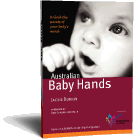 As well as educating parents on the benefits of using baby sign language with children, I have spent the last number of years educating parents on sign language and sign language systems in general.
As well as educating parents on the benefits of using baby sign language with children, I have spent the last number of years educating parents on sign language and sign language systems in general.
People are amazed to find out that there was a difference between the sign language system Australian people use and that of people in other countries. “Auslan or ASL, what’s the difference and what should I use?”, were common questions. To them, they had assumed that there was only one sign language system and it was universal.
To put this in context, I would refer to how there are many people around the world who speak English but they have adopted it and made it their own through colloquialisms and slang. Think of a person speaking English in England and a person speaking English in Australia. The same is true for sign language. While the Australian sign language system has its roots in British Sign Language (BSL) and Irish Sign Language (ISL), Auslan (Australian Sign Language) has evolved to what it is today.
There is a universal sign language system which was formally known as Gestuno. Today it is known as International sign language. This sign language system was not created to replace any pre-existing signed languages but to have a language that could be used at international meetings, conventions and games. As it does not have a concrete grammar, some say that it is not a real language. International Sign Language is used at international meetings, conventions and games.
As well as these country specific signed languages, there are also a lot of questions on the differences between a number of signing systems that exist in Australia. These signing systems include Makaton, Signed English and Baby Sign. People ask me frequently how do these differ from Auslan and what is the best system to use.
Makaton is defined by LaTrobe University as “….a key word signing system that aims to provide a basic means of communication and encourage language development. Makaton comprises of a small vocabulary derived from Australasian Signed English and Australian Sign Language (AUSLAN). ” Makaton is a method of key-word signing for people with intellectual or development disabilities.
The Makaton vocabulary was developed in England by Margaret Walker in the early 1970’s and was introduced to Australia by Anne Cooney in 1977. The Makaton key-signing system utilises gesture, pictures and diagrams to assist communication. The core system includes a short list of approx 320 signs, divided under 9 stages of learning. Makaton is generally used as either an alternative to spoken and written language, or as a language support tool. It is however not a language. In 2010, Makaton Australia was renamed Key Word Sign Australia.
Signed English, like Makaton is not a language. Signed English is a sign system which was established to match word-for-word to the spoken English language. This is mainly used in educational facilities. It signs every word in a sentence and the theory of it is that it would help deaf children with their English grammar. While it borrows a lot of its signs from Auslan, there is a lot of confusion between the two but Signed English is very different from Auslan.
So where does Baby Sign Language fit into all of this? The first question I would ask any company doing baby sign language is what are their signs based on? There are a lot of companies who use BSL (British Sign Language), ASL (American Sign Language), a mixture of signed languages or made up gestures when created their Baby Sign Language system.
Australian Baby Hands uses Auslan (Australian Sign Language) signs. The signs in our products have been reviewed and our products are accredited Auslan products.
Baby Sign Language, like signed English or Makaton is not a language in its own right. It merely borrows the signs used in Auslan to help parents communicate with their pre-verbal child.
Baby Sign is also similar to Makaton/Key Signs in that it does not have its own grammar. When using Baby Signs with your child, you sign the main words in the sentence which are the most practical or motivational signs for your baby to learn. Baby Sign is a great stepping stone into learning Auslan as it helps build up your Auslan vocabulary.
I hope this article has helped explain to you both the difference between the international signed languages as well as the various signing systems in Australia.
